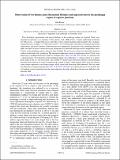Observation of two distinct pairs fluctuation lifetimes and supercurrents in the pseudogap regime of cuprate junctions
Author(s)
Koren, Gad; Lee, Patrick A
DownloadPhysRevB.94.174515.pdf (744.0Kb)
PUBLISHER_POLICY
Publisher Policy
Article is made available in accordance with the publisher's policy and may be subject to US copyright law. Please refer to the publisher's site for terms of use.
Terms of use
Metadata
Show full item recordAbstract
Pairs fluctuation supercurrents and inverse lifetimes in the pseudogap regime are reported. These were measured on epitaxial c-axis junctions of the cuprates, with a PrBa[subscript 2]Cu[subscript 3]O[subscript 7−δ] barrier sandwiched in between two YBa[subscript 2]Cu[subscript 3]O[subscript 7−δ] or doped YBa[subscript 2]Cu[subscript 3]O[subscript y] electrodes, with or without magnetic fields parallel to the a-b planes. All junctions had a T[subscript c](high)≈85–90 K and a T[subscript c](low)≈50–55 K electrodes, allowing us to study pairs fluctuation supercurrents and inverse lifetimes in between these two temperatures. In junctions with a pseudogap electrode under zero field, an excess current due to pair fluctuations was observed which persisted at temperatures above T[subscript c](low), in the pseudogap regime, and up to about T[subscript c](high). No such excess current was observed in junctions without an electrode with a pseudogap. The measured conductance spectra at temperatures above T[subscript c](low) were fitted using a modified fluctuations model by Scalapino [Phys. Rev. Lett. 24, 1052 (1970)] of a junction with a serial resistance. We found that in the pseudogap regime, the conductance vs voltage consists of a narrow peak sitting on top of a very broad peak. This yielded two distinct pairs fluctuation lifetimes in the pseudogap electrode which differ by an order of magnitude up to about T[subscript c](high). Under in-plane fields, these two lifetime values remain separated in two distinct groups, which varied with increasing field moderately. We also found that detection of Amperian pairing [Phys. Rev. X 4, 031017 (2014)] in our cuprate junctions is not feasible, due to Josephson vortices penetration into the superconducting electrodes which drove the necessary field above the depairing field.
Date issued
2016-11Department
Massachusetts Institute of Technology. Department of PhysicsJournal
Physical Review B
Publisher
American Physical Society
Citation
Koren, Gad, and Patrick A. Lee. “Observation of Two Distinct Pairs Fluctuation Lifetimes and Supercurrents in the Pseudogap Regime of Cuprate Junctions.” Physical Review B 94.17 (2016): n. pag. © 2016 American Physical Society
Version: Final published version
ISSN
2469-9950
2469-9969